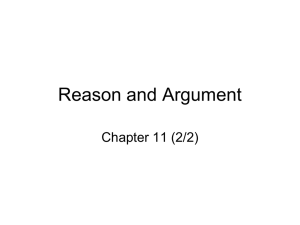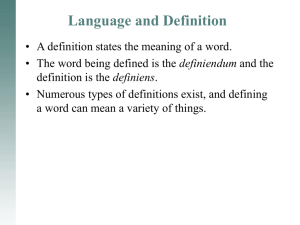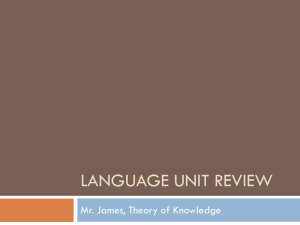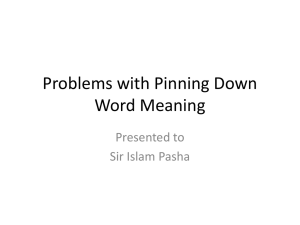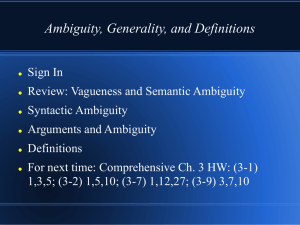Chapter 3 Powerpoint Presentation
advertisement
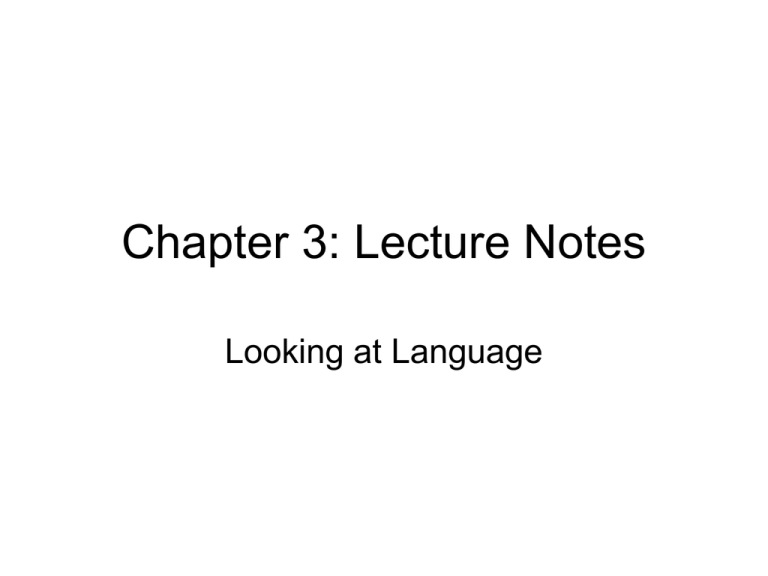
Chapter 3: Lecture Notes Looking at Language Chapter 3: Looking at Language Language is an essential tool of thought and for arguments as well. At every stage of constructing, understanding, and evaluating argument we have to understand the language. It is much easier to use language than it is to think critically about it. (57) Phrases like: regime change or mankind can indicate that there are assumptions that might not be legitimate. For example, are all regimes bad? When talking of mankind are we including women in the story? All of this will matter when evaluating arguments. Chapter 3 Use vs. Mention One important distinction is the difference between using words and talking about words. Consider the following examples. (a) New York is disyllabic. (b) “New York” is disyllabic. (a) is false because New York the city is not disyllabic. But (b) is true because the word/phrase “New York” is a two syllable name. In (a) we are using the word, in (b) mentioning it. Chapter 3 Emotionally Charged Language Emotionally charged language is sometimes called “loaded language” and it functions to create a mood or attitude without argument or reasons. Consider the difference in these two phrases: (i) Diversion of funds (ii) Reform The first has a negative feel or attitude, but the second does not. Chapter 3 Neutrality in emotional tone with language is probably impossible, and if possible would make language boring. Just because an argument has loaded language in it does not mean that the argument is meritless. Chapter 3 Euphemism A euphemism is a bland, abstract, or polite use of language used to refer to something that would otherwise be embarrassing, demeaning, appalling, or horrible. Collateral damage is a euphemism for the killing of innocents bystanders Pushing up daisies and kicking the bucket are euphemisms for death. Chapter 3 Euphemisms are often funny: vertically challenged for shot people follically challenged for bald people Euphemisms become a block to thought and understanding when they are used to block aspects of reality involving serious matters like harm, torture, false arrests, poverty, war, and humiliation. Chapter 3 Two types of unclear language that gives rise to problems in arguments are: Ambiguity and Vagueness Chapter 3 Ambiguity occurs when a word or phrase may have several meanings, any of which, could fit naturally in the context being used. This newspaper headline for example, “Home Delivery Sought” There are several natural interpretations of this phrase, which means it is ambiguous: (i) (ii) (iii) Giving birth at home instead of at the hospital Getting mail delivered to residences Having a house delivered Context can matter and often solves the problem of ambiguity for us in what interpretation to use. Chapter 3 There are two basic types of ambiguity: Semantic and Syntactic Semantic ambiguity has to do with the meaning of the words and occurs when there is more than one possible meaning of the word in question. Bank and right are two words with multiple meaning that can give rise to ambiguous sentences if you don’t know the context in question. Chapter3 Syntactic ambiguity are due to issues of structure of a phrase or the sentence. “It is time for football and meatball stew” Is syntactically ambiguous because of the linking of football with meatball. Poor writing often gives rise to syntactic ambiguity and this example could have been eliminated if it had been written this way: “It is time for meatball stew and football.” Chapter 3 When an argument relies on or has an instance of ambiguity in it, it is a mistaken in reasoning. When this mistake occurs in an argument it is called the fallacy of equivocation. For example: I have the right to vote for higher taxes. Therefore, I did the right thing voting for higher taxes. In this case the word ‘right’ is being used in two sense, and this means that the premise doesn’t support the conclusion in the way intended by the author. Chapter 3 Vagueness Vagueness is a lack of distinctness of meaning. To be contrasted with ambiguity, vagueness has unclear meanings, while ambiguous words and phrases have multiple meanings. I have a big house is vague. Big is vague because there is not clear sense in when a house is big. Three bedrooms or 30 bedrooms. Big is used vaguely in this context. Chapter 3 Understanding definitions is an important part of understanding arguments. There are several different kinds of definitions that a person could give or use. We shall look at several that are important to evaluating arguments and language. Chapter 3 Ostensive Definitions In an ostensive definition of a word, X, we explain what X means by pointing to an example of X. Trying to give an English definition of a ‘cat’ would be difficult. So, what we often do when we want to define a word, like ‘cat’, is to point to the object – like a real cat. Since one main goal of language is to relate words to the real world, ostensive definitions work quite well. Chapter 3 Reportive or Lexical Definitions Reportive (lexical or dictionary) definitions have the goal of accurately describing how a word is used in language. Typically this is done by clearly explaining the properties a things has. For a word like ‘chair’ it might report that a chair is a “piece of furniture that is to seat one person” or something similar. It seems an easy task, but ‘chair’ can have other meanings. Chapter 3 ‘chair’ is also used in the following ways: (i) As chair, she called the meeting to order. (ii) The college established a chair of moral philosophy. In (i) the chair is the person in charge of the meeting. In (ii) the chair in question is an endowed professorship. So, we will need some guidelines for creating good reportive definitions. Chapter 3 Reportive definition guidelines: 1. It is not too broad. That is to say, all things that the definition would have us call X are called X in ordinary language 2. It is not too narrow. That is to say, all the things that are called X in ordinary usage are called X according to the definition. 3. It is not couched solely in negative terms unless X itself is negative. 4. It defines the word X in terms of features required for a things to could as X and not in terms of incidental features, 5. It uses terms that, for the most in need of a definition, will be clearer than the term being defined. 6. It uses terms that are sufficiently removed from the term being defined that it is not circular. Chapter 3 Stipulative Definition A stipulative definition is one in which someone specifies what the usage of a word is. This can be done for words like rich or tall. I could define tall for a man as over 6 feet. This would be a stipulative definition. When a person tries to win an argument by defining the terms how they like instead of how they are used, it is an instance of victory by definition and is a kind of fallacy. Chapter 3 Persuasive Definition A persuasive definition is a stipulative definition disguised as a claim or as a reportive definition. These kinds of definitions attempt to keep the emotional connotation of a word while changing its application. So, freedom fighters as a term for rebels or terrorists or assassins is an example of a persuasive definition. Chapter 3 Operational Definitions Operational definitions are a kind of stipulative definition most often used in scientific research. For example, A substance is soluble if, and only if, it dissolves when placed in water. So, soluble is defined operationally. Chapter 3 Terms to review: Ambiguity Argument by epithet Connotation Denotation Emotionally charged language Fallacy Fallacy of equivocation Figurative meaning Lexical Definition Literal meaning Loaded language Mention (of a word) Neutral Language Operational Definition Ostensive definition Chapter 3 Terms to review continued: Persuasive definition Semantic ambiguity Syntactic ambiguity Reportive definition Stipulative definition Vagueness


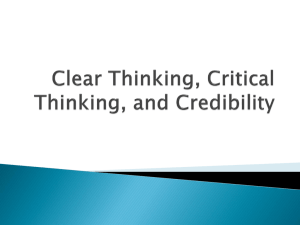
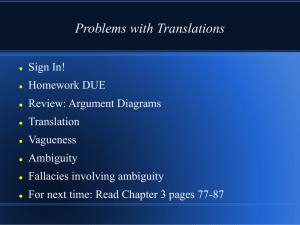
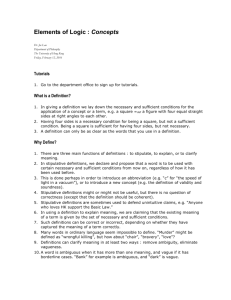
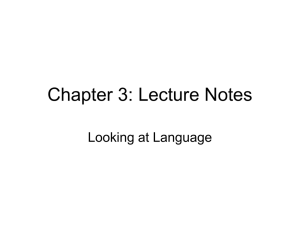
![[M01] Meaning analysis](http://s3.studylib.net/store/data/007533454_2-0783339e4cb4f28dcdc58ea37177f893-300x300.png)
